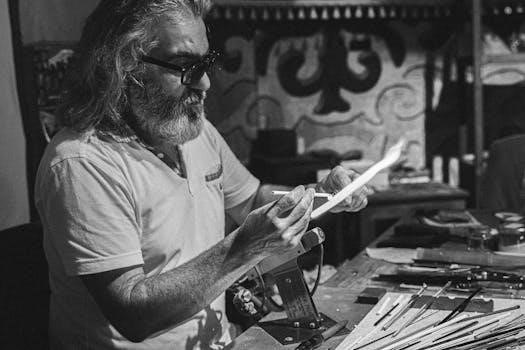Cannon Manual Downrigger⁚ A Comprehensive Guide
Embark on a journey to master controlled-depth fishing with Cannon manual downriggers. This comprehensive guide provides an overview of Cannon’s manual downrigger series, designed for precision and reliability. Learn how these tools enhance your fishing experience, offering an effective way to target fish at specific depths with ease.
Cannon manual downriggers offer anglers a reliable and straightforward approach to controlled-depth fishing. These downriggers, known for their robust design and ease of use, are ideal for both novice and experienced fishermen seeking precision in their fishing endeavors. The series includes models like the Uni-Troll, Easi-Troll, Lake-Troll, and Mini-Troll, each tailored to different boat sizes and fishing styles.
Manual downriggers provide a tactile feel for adjusting depth and monitoring the fishing line. Their simple mechanics minimize potential points of failure, making them a durable choice for various fishing conditions. With fewer moving parts, these downriggers are easy to maintain, ensuring longevity and consistent performance on the water.
Cannon’s manual downriggers allow anglers to precisely target fish at specific depths, increasing the chances of a successful catch. Whether trolling for salmon in the Great Lakes or targeting trout in smaller waters, these downriggers offer the control and reliability needed to excel in controlled-depth fishing scenarios.
Understanding Downrigger Functionality
Downriggers are essential tools for anglers who want to present their bait at precise depths. Their primary function is to suspend a fishing line and lure at a predetermined depth, allowing for targeted fishing in various water conditions. A downrigger consists of a spool of cable, a weight (often referred to as a cannonball), and a release mechanism.
The cable is lowered into the water with the weight attached, pulling the fishing line down to the desired depth. The line is secured to the downrigger cable using a release clip. When a fish strikes, the line is released from the clip, allowing the angler to fight the fish without the weight.
Manual downriggers operate via a hand crank, enabling the angler to raise or lower the weight. This manual control provides a direct feel for the depth and resistance, aiding in precise adjustments. The depth meter on the downrigger indicates the amount of cable released, helping maintain the desired fishing depth. Understanding these core functions ensures effective use of a downrigger.

Available Cannon Manual Downrigger Models (Uni-Troll, Easi-Troll, Lake-Troll, Mini-Troll)
Cannon offers a range of manual downrigger models, each designed to suit different fishing needs and boat sizes. The Uni-Troll series is known for its robust construction and versatile features, making it suitable for various fishing environments. The Easi-Troll model provides a user-friendly design, ideal for anglers seeking simplicity and ease of use.

For smaller boats and inland lakes, the Lake-Troll is a compact and efficient option. Its lightweight design ensures easy handling and storage. The Mini-Troll is the most portable model, perfect for anglers who need a downrigger that can be easily moved between boats or stored in tight spaces.
Each of these models offers manual operation, allowing for precise depth control and a direct feel for the fishing conditions. Selecting the right model depends on the size of your boat, the type of fishing you plan to do, and your personal preferences for features and ease of use. Cannon provides options to suit every angler’s needs.
Key Features and Specifications
Cannon manual downriggers are engineered with several key features to enhance performance and durability. One notable aspect is their composite construction, providing corrosion resistance and ensuring longevity even in harsh marine environments. The design incorporates fewer moving parts, simplifying operation and reducing the likelihood of mechanical issues.
These downriggers typically feature a depth counter for accurate bait placement, allowing anglers to target specific depths with precision. The adjustable rod holders accommodate various rod sizes and fishing styles, while the easy-to-use crank handles offer smooth and efficient retrieval. Many models also include a line release system, such as the Cannon Uni-Release, ensuring reliable hooksets.
Specifications vary depending on the model, with differences in boom length, weight capacity, and mounting options. The Uni-Troll series often includes a longer boom and higher weight capacity compared to the Lake-Troll or Mini-Troll models. Consider these specifications to choose a downrigger that matches your boat size and the types of fish you intend to target.
Mounting and Installation Guide
Proper mounting and installation are crucial for the optimal performance of your Cannon manual downrigger. Begin by selecting a suitable location on your boat’s gunwale or deck, ensuring it provides ample space for operation and doesn’t interfere with other equipment. Consider using a mounting plate to add stability, especially on thinner decks.
The installation process typically involves drilling holes to secure the downrigger base. Use the base as a template to mark the hole locations accurately. For decks up to 7/16 inch thick, you can mount the base directly using appropriate hardware. If access to the underside of the deck is limited, wellnuts can be employed for secure fastening.
For thinner decks, using a Cannon deck plate is recommended to prevent deflection and enhance stability. Ensure all connections are tightened securely to prevent movement during use. After mounting the base, attach the boom and crank handle assembly, making sure the boom locking screw is properly engaged. Refer to the owner’s manual for specific instructions related to your model.

Choosing the Right Mounting Accessories
Selecting the appropriate mounting accessories is essential for securely installing your Cannon manual downrigger and ensuring its optimal performance. Cannon offers a range of mounting options to accommodate various boat types and configurations. Consider the thickness and material of your boat’s deck or gunwale when making your selection. Deck plates are ideal for providing added stability on thinner surfaces, preventing deflection and ensuring a secure fit.
Side/rail mounts offer versatility for boats with welded T-sections or rail systems. For installations where access to the underside of the deck is limited, wellnuts provide a convenient and reliable fastening solution. When choosing mounting hardware, opt for stainless steel components to resist corrosion and withstand the harsh marine environment.
Evaluate the available space and potential obstructions on your boat to determine the most suitable mounting location. Ensure the chosen accessories are compatible with your specific downrigger model and allow for easy operation and adjustment. Proper mounting accessories are critical for a safe and effective downrigger setup.
Step-by-Step Installation Instructions
Follow these step-by-step instructions for a successful Cannon manual downrigger installation. Begin by selecting the desired mounting location on your boat, ensuring adequate space and accessibility. Use the mounting base as a template to mark the hole locations on the deck or gunwale. Drill the necessary holes, referring to the specifications in your downrigger’s manual.
If using a deck plate, align it with the marked holes and secure it to the boat using appropriate fasteners, such as screws and wellnuts. Attach the mounting base to the deck plate or directly to the boat, ensuring a snug and secure fit. Insert the downrigger boom into the frame, making sure it is firmly seated and secured with the boom locking screw.
Attach the crank handle assembly, ensuring the thrust bearing is properly positioned. Thread the crank handle onto the shaft and tighten until the clutch is fully engaged. Finally, connect the downrigger cable and test the system to ensure smooth operation. Double-check all connections and fasteners to guarantee a safe and reliable installation. Consult your downrigger’s manual for detailed diagrams and specific torque specifications.
Operating Your Cannon Manual Downrigger
Operating your Cannon manual downrigger involves several key steps to ensure effective controlled-depth fishing. First, release line from your rod and reel, creating a “drop back” of approximately 5 to 100 feet behind the boat. This distance allows your lure to trail naturally. Next, securely attach your fishing line to the line release mechanism on the downrigger cable. Cannon offers various release options, including the Uni-Release and Terminator.
Lower the downrigger weight to the desired depth by cranking the handle. Monitor the depth using the depth meter, which can be reset for accuracy. Remember that the actual fishing depth may vary due to trolling speed and weight. Adjust your trolling speed to maintain the desired lure action and depth, accounting for blowback—the angle of the downrigger cable caused by water resistance.
When a fish strikes, the line releases from the clip, allowing you to fight the fish directly with your rod and reel. Retrieve the downrigger weight after landing the fish to reset for another pass. Regularly check and adjust your setup to optimize your fishing strategy based on conditions and fish behavior. Practice makes perfect!
Setting the Depth and Adjusting the Meter
Accurately setting the depth is crucial for effective downrigger fishing. Begin by determining the target depth where fish are likely to be located, using sonar or prior knowledge of the fishing area. Deploy your Cannon manual downrigger and lower the weight by cranking the handle. Observe the depth meter as the weight descends, noting the indicated depth.
The Cannon depth meter is designed for non-slip accuracy and easy resetting. To adjust the meter, gently slide it away from the reel until the gears disengage. Then, spin the meter gear to change the setting, aligning it with your desired depth. Once set, release the meter to re-engage the gears, locking in the new depth reading.
Keep in mind that the actual fishing depth may vary slightly from the meter reading due to factors like trolling speed and weight. Regularly monitor the meter and adjust as needed to maintain your lure at the optimal depth. Consistent and accurate depth setting significantly improves your chances of success.
Line Release Mechanisms (Cannon Uni-Release, Terminator)
Line release mechanisms are vital components of any downrigger system, ensuring that your fishing line detaches from the downrigger weight upon a strike. Cannon offers two primary release options⁚ the Uni-Release and the Terminator. Each provides reliable performance and ease of use, catering to different fishing styles and preferences.
The Cannon Uni-Release is a popular choice known for its adjustable tension; This allows anglers to fine-tune the release sensitivity based on the size and fighting ability of the targeted fish. To use the Uni-Release, simply clip your fishing line into the jaws of the release. When a fish strikes, the line pulls free, allowing you to fight the fish unencumbered by the downrigger weight.
The Terminator release features a streamlined design for secure line holding. To set up the Terminator, slide the cushion over the top and give it a test pull to ensure a secure connection. Both release mechanisms are designed for easy attachment and detachment, providing a seamless transition from trolling to fighting the fish. Proper adjustment and maintenance of your chosen release system are essential for optimal performance.
Maintenance and Troubleshooting
Proper maintenance is crucial for extending the lifespan and ensuring the reliable performance of your Cannon manual downrigger. Regular cleaning and lubrication of moving parts will prevent corrosion and ensure smooth operation. After each use, rinse the downrigger with fresh water, paying particular attention to the cable, reel, and release mechanism. Periodically lubricate the reel gears and other moving parts with a marine-grade grease or lubricant.

Common issues can include cable fraying, difficulty reeling, or issues with the line release. Inspect the cable regularly for signs of wear and replace it if necessary. If you experience difficulty reeling, check for obstructions or corrosion in the reel mechanism. Disassembling and cleaning the reel may be required. If the line release fails to function properly, inspect it for damage or debris and adjust the tension as needed.
If you encounter more complex problems, consult the owner’s manual or contact Cannon customer support for assistance. Remember to retain the serial number and purchase date for warranty service inquiries. With proper care and attention, your Cannon manual downrigger will provide years of reliable service.
Safety Precautions and Best Practices
Operating a Cannon manual downrigger safely requires attention to detail and adherence to best practices. Before each use, inspect the downrigger for any signs of damage or wear. Ensure that all mounting hardware is secure and that the cable is in good condition. Never exceed the recommended weight capacity of the downrigger, as this can lead to equipment failure or personal injury.
When deploying or retrieving the downrigger weight, be aware of your surroundings and maintain a safe distance from other boats and obstacles. Use caution when handling the cable, as it can be sharp and cause cuts. Always wear appropriate personal protective equipment, such as gloves and eye protection, when working with the downrigger.
Avoid using the downrigger in rough seas or adverse weather conditions, as this can increase the risk of accidents. Be mindful of electrical hazards when using electric downriggers and ensure that all wiring is properly grounded. Finally, familiarize yourself with local regulations and guidelines regarding the use of downriggers in your area. By following these safety precautions and best practices, you can enjoy a safe and productive fishing experience.
Warranty and Service Information
Cannon downriggers are backed by a limited lifetime warranty, offering peace of mind and protection against manufacturing defects. This warranty covers the repair or replacement of defective parts, ensuring that your downrigger performs optimally for years to come. To initiate a warranty claim, contact Cannon’s customer service department or visit their website for detailed instructions.
In the event that your downrigger requires service or repair, Cannon provides a network of authorized service centers. These centers are staffed by trained technicians who can diagnose and resolve any issues you may encounter. Before sending your downrigger in for service, be sure to obtain a return authorization number and include proof of purchase.
For routine maintenance and troubleshooting, refer to the owner’s manual for helpful tips and guidance. If you are unable to resolve the issue yourself, contact Cannon’s technical support team for assistance. They can provide expert advice and help you determine the best course of action. Remember to retain your purchase receipt and warranty information for future reference, as they may be required for warranty claims or service requests.
